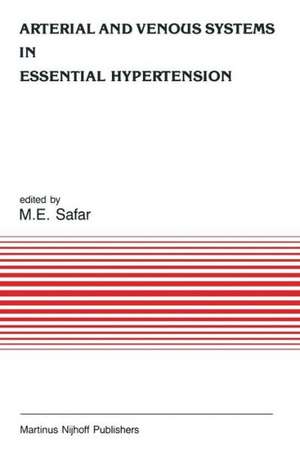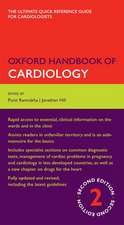Arterial and Venous Systems in Essential Hypertension: Developments in Cardiovascular Medicine, cartea 63
G.M. London Editat de Michel Emile Safar A.Ch. Simon, Y.A. Weissen Limba Engleză Paperback – 3 noi 2011
Din seria Developments in Cardiovascular Medicine
- 5%
 Preț: 1484.50 lei
Preț: 1484.50 lei - 5%
 Preț: 375.17 lei
Preț: 375.17 lei - 5%
 Preț: 354.10 lei
Preț: 354.10 lei - 5%
 Preț: 1408.56 lei
Preț: 1408.56 lei - 5%
 Preț: 373.66 lei
Preț: 373.66 lei - 5%
 Preț: 1090.17 lei
Preț: 1090.17 lei - 5%
 Preț: 1427.76 lei
Preț: 1427.76 lei - 5%
 Preț: 374.03 lei
Preț: 374.03 lei - 5%
 Preț: 365.66 lei
Preț: 365.66 lei - 5%
 Preț: 377.46 lei
Preț: 377.46 lei - 5%
 Preț: 2101.92 lei
Preț: 2101.92 lei - 5%
 Preț: 364.59 lei
Preț: 364.59 lei - 5%
 Preț: 363.86 lei
Preț: 363.86 lei - 5%
 Preț: 368.38 lei
Preț: 368.38 lei - 5%
 Preț: 368.21 lei
Preț: 368.21 lei - 5%
 Preț: 777.43 lei
Preț: 777.43 lei - 5%
 Preț: 707.93 lei
Preț: 707.93 lei - 5%
 Preț: 1090.17 lei
Preț: 1090.17 lei - 5%
 Preț: 372.75 lei
Preț: 372.75 lei - 5%
 Preț: 370.76 lei
Preț: 370.76 lei - 5%
 Preț: 718.61 lei
Preț: 718.61 lei - 5%
 Preț: 1095.98 lei
Preț: 1095.98 lei - 5%
 Preț: 2101.56 lei
Preț: 2101.56 lei - 5%
 Preț: 710.81 lei
Preț: 710.81 lei - 5%
 Preț: 369.31 lei
Preț: 369.31 lei - 5%
 Preț: 717.02 lei
Preț: 717.02 lei - 5%
 Preț: 655.23 lei
Preț: 655.23 lei - 5%
 Preț: 372.58 lei
Preț: 372.58 lei - 5%
 Preț: 1412.72 lei
Preț: 1412.72 lei - 5%
 Preț: 710.09 lei
Preț: 710.09 lei - 5%
 Preț: 784.88 lei
Preț: 784.88 lei - 5%
 Preț: 715.37 lei
Preț: 715.37 lei - 5%
 Preț: 3161.94 lei
Preț: 3161.94 lei - 5%
 Preț: 1407.80 lei
Preț: 1407.80 lei - 5%
 Preț: 778.87 lei
Preț: 778.87 lei - 5%
 Preț: 709.36 lei
Preț: 709.36 lei - 5%
 Preț: 368.03 lei
Preț: 368.03 lei - 5%
 Preț: 373.47 lei
Preț: 373.47 lei - 5%
 Preț: 655.99 lei
Preț: 655.99 lei - 5%
 Preț: 365.66 lei
Preț: 365.66 lei
Preț: 368.21 lei
Preț vechi: 387.60 lei
-5% Nou
Puncte Express: 552
Preț estimativ în valută:
70.52€ • 72.65$ • 59.07£
70.52€ • 72.65$ • 59.07£
Carte tipărită la comandă
Livrare economică 22 februarie-08 martie
Preluare comenzi: 021 569.72.76
Specificații
ISBN-13: 9789401079839
ISBN-10: 9401079838
Pagini: 336
Ilustrații: VIII, 323 p.
Dimensiuni: 155 x 235 x 18 mm
Greutate: 0.47 kg
Ediția:Softcover reprint of the original 1st ed. 1987
Editura: SPRINGER NETHERLANDS
Colecția Springer
Seria Developments in Cardiovascular Medicine
Locul publicării:Dordrecht, Netherlands
ISBN-10: 9401079838
Pagini: 336
Ilustrații: VIII, 323 p.
Dimensiuni: 155 x 235 x 18 mm
Greutate: 0.47 kg
Ediția:Softcover reprint of the original 1st ed. 1987
Editura: SPRINGER NETHERLANDS
Colecția Springer
Seria Developments in Cardiovascular Medicine
Locul publicării:Dordrecht, Netherlands
Public țintă
ResearchCuprins
I - Small arteries and the concept of resistance.- Hemodynamic basis for the concept of resistance and impedance in hypertension.- Structural component of vascular resistance in hypertension.- Baroreflex mechanisms and the high pressure system in hypertension.- II - Low pressure system and the concept of venous distensibility.- Venous compliance in essential hypertension.- Functional and structural components of reduced forearm venous disten- sibility in human hypertension.- Cardiac mechanoreceptors in hypertension.- Venous system, extracellular fluid volume and the kidney in essential hypertension.- III - Large vessels and the concept of arterial compliance.- Systolic hypertension in the elderly.- Large arteries in borderline and sustained essential hypertension.- Pulse wave velocity and hypertension.- Renin-angiotensin system and arterial wall in hypertension.- IV - Regional circulations.- The coronary circulation in hypertensive left ventricular hypertrophy.- Carotido-cerebral circulation in patients with sustained essential hypertension.- Renal circulation in essential hypertension.- Hepato-splanchnic circulation in human hypertension.- V - Forearm circulation as a model for the study of hypertension.- Methods for investigation of forearm blood flow.- The contribution of alpha-1 and alpha-2-adrenoceptor mediated vasoconstriction in essential hypertension as assessed by forearm venous occlusion plethysmography.- Beta-adrenergic receptors and the forearm circulation.- Converting enzyme inhibitors and hypertensive large arteries.- Calcium entry blockers and the forearm arterial bed.- Cations and the forearm circulation in hypertensive humans.- Conclusion.- Homeostatic mechanisms and structural modifications of the cardiovascular system in essential hypertension.- Listof contributors.










